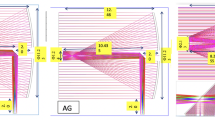Abstract
Telescopes with aperture higher than 3 m and with travel rate of optical axis of more than 4 angular degrees per second are examined. These telescopes are used for estimating the situation in near-Earth space. Up to now, there are three telescopes with such parameters: SOR, AMOS, SST (all in the United States). A telescope of the same class with aperture of 3.12 m (information telescope TI-3.12) is under completion at Altai Optical Laser Center. The main technical performances of the TI-3.12 telescope are described in the paper. Current problems are defined and ways for their solution are presented.
Similar content being viewed by others
References
V. P. Aleshin, “The ground based imaging of spacecraft and inverse problems,” Elektromagn. Volny Elektron. Sist. 19 (8), 60–67 (2014).
V. P. Aleshin, Yu. Yu. Balega, E. A. Grishin, et al., “The imaging of geostationary spacecrafts using large aperture telescopes for space situational awareness,” Elektromagn. Volny Elektron. Sist. 16 (3), 9–17 (2011).
V. P. Aleshin, Yu. Yu. Balega, A. F. Maksimov, et al., “Speckle interferometry of geostationary satellites: Reality and perspectives,” in Proc. Int. Conf. Near-Earth Astronomy–2011, Krasnoyarsk, Sept. 5–10, 2011; Vestn. Sib. Gos. Aerokosm. Univ., No. 6, 154–158 (2011).
V. P. Aleshin, D. D. Novgorodtsev, V. G. Vygon, et al., “Estimation of nonoperating spacecrafts motion near center of mass using the real optical observations,” in Proc. Int. Conf. Near-Earth Astronomy–2013, Agoi, Russia, Oct. 7–11, 2013; Ekol. Vestn. Nauchn. Tsentrov Chernomorsk. Ekon. Sotr., Nos. 4–2, 7–14 (2013).
M. R. Ackermann, R. R. Kiziah, P. C. Zimmer, et al., “Alternatives for ground-based, large-aperture optical space surveillance systems,” in Proc. 2013 Advanced Maui Optical and Space Surveillance Technical Conf. (AMOS 2013), Maui, HI, Sept. 10–13, 2013 (Maui Econ. Dev. Board, Maui, HI, 2013).
V. P. Aleshin, E. A. Grishin, D. D. Novgorodtsev, and V. D. Shargorodsky, “Monitoring of near-space anthropogenic pollution by observation of the Altay laser-optical center,” in Proc. Int. Conf. on One Wave-Two Wave Laser Range Estimation, St. Petersburg, 2012 (St. Petersburg, 2012), pp. 76–78.
V. P. Aleshin, E. A. Grishin, V. D. Shargorodsky, and D. D. Novgorodtsev, “Altay optic-laser center capability to satellites emergencies estimation,” in Proc. 9th US/Russian Space Surveillance Workshop, Listvyanka, Russia, Aug. 27–30, 2012 (Dep. Aerospace Eng., 2012).
AMOS User’s Manual, Revision 12 (Boeing, Kihei, HI, 2001).
L. del Monte, “European approach to space situational awareness, security strategy and partner ships development office DG Policy Office European Space Agency,” Presented at Fourth European Space Weather Week, Brussels, Nov. 5–9, 2007.
A. H. Douglas, M. J. Stuart, and C. Giebink, “Imaging geo-synchronous satellites with the AEOS Telescope,” in Proc. 2010 Advanced Maui Optical and Space Surveillance Technical Conf. (AMOS 2010), Maui, HI, Sept. 14–17, 2010 (Maui Econ. Dev. Board, Maui, HI, 2010).
R. Shah, D. F. Woods, W. Faccenda, et al., “Asteroid detection with the space surveillance telescope,” in Proc. 2012 Advanced Maui Optical and Space Surveillance Technical Conf. (AMOS 2012), Wailea, HI, Sept. 11–14, 2012 (Maui Econ. Dev. Board, Maui, HI, 2012).
S. M. Jefferies, D. A. Hope, and C. A. Giebink, “Next generation image restoration for space situational awareness,” Air Force Office of Scientific Research Report, Grant No. FA9550-06-1-0179 (2009).
V. Yu. Terebizh, “A wide-field corrector at the prime focus of a Ritchey-Chretien telescope,” Astron. Lett. 30, 200–208 (2004). http://xxx.lanl.gov/abs/astro-ph/0402212.
D. F. Woods, R. Shah, J. Johnson, et al., “The space surveillance telescope: focus and alignment of a three mirror telescope,” in Proc. 2013 Advanced Maui Optical and Space Surveillance Technical Conf. (AMOS 2013), Maui, HI, Sept. 10–13, 2013 (Maui Econ. Dev. Board, Maui, HI, 2013).
Author information
Authors and Affiliations
Corresponding author
Additional information
Original Russian Text © V.P. Aleshin, E.A. Grishin, O.A. Ivlev, D.D. Novgorodtsev, V.D. Shargorodsky, 2016, published in Kinematika i Fizika Nebesnykh Tel, 2016, Vol. 32, No. 5, pp. 68–74.
About this article
Cite this article
Aleshin, V.P., Grishin, E.A., Ivlev, O.A. et al. Large-aperture telescopes in the problems of near-Earth astronomy. Kinemat. Phys. Celest. Bodies 32, 255–259 (2016). https://doi.org/10.3103/S0884591316050020
Received:
Published:
Issue Date:
DOI: https://doi.org/10.3103/S0884591316050020




